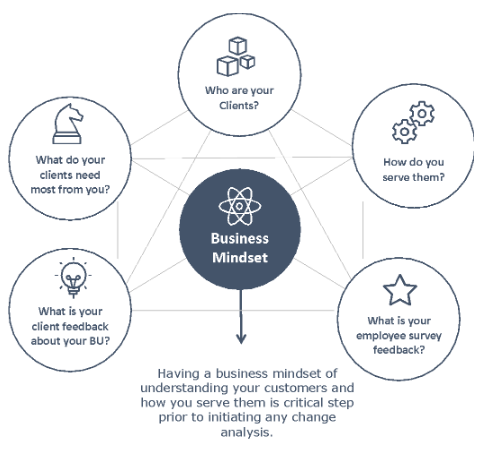There are many offramps impacting the success of business change. Analyzing a business’s readiness and culture prior to initiating any changes, is a critical weapon to thrive in this dynamic world. This article will align us on the definition of change analysis and the approach aimed to mitigate this offramp for you and position your company for cutting-edge changes to come.
What is change analysis in business?
For alignment, change analysis strategies aim to comprehend and assess the effects of changes in your corporate environment. It entails detecting and evaluating the potential internal and external effects of recent events, followed by developing an effective change management strategy.
Typically administered after the organization decides a change is required, experts at Rhodes Smith have found that waiting to capture this analysis is reactionary and positions the organization and project teams in a vulnerable position. Experience has shown that understanding and refreshing this information every quarter is a foundational step prior to initiating any change.
Business Mindset – Proactive Steps For Analysis?
The management of any change requires executive sponsors and leaders to be proactive in their organization and stakeholders analysis. There is a direct correlation between the management of change through a project and its sustainment with the current actions of the business. This requires leaders and business units to think of themselves as mini-businesses and have information readily available regarding their current landscape – agnostic of any change in the future. This level of analysis is captured through the following analysis:
- Client Strategies & Concerns:
How well do you know what keeps your clients up right now and where they are going? Being clear on the interests, concerns, and strategies of your clients and key stakeholders prior to change allows you and your business unit clarity to support them in the right way. - Service You Support Client Strategies:
Based on what your clients strategies and concerns are, do you and your business units know how they provide service them? Documenting and promoting how you and your teams help clients with their strategies demonstrates cross functional interaction and engagement that fosters an “we” mentality versus being boxed into silos. - Client Needs From You:
What do your clients need most from you? Based on these strategies, you can determine what they need most from you (e.g. process, technology, etc.) so they are effective. - Customer Service Survey:
Do your clients / stakeholders believe you are adding value to them? Understanding current perceptions of engagement or how your teams are supporting your clients is important. Survey’s through client feedback forms or identifying the top 5 themes your clients call your team for support will identify current pain points and how your team can help. Not acknowledging current pain points may create frustration from clients whom you need support and engagement from during times of change. - Organization / Culture Survey:
What are you or the organization currently not doing well as leaders? Top and bottom 5 themes collected from employee or culture survey’s offer additional analysis the organizational climate. Change approaches – at their core – are built on engagement, communication, and training, which are areas often measured through these assessments. This information will help identify what components employees feel the biggest need – on top of changes they are not aware are coming.
As with any business, understanding your client and key stakeholders, their challenges, and needs fosters better engagement and communication. This early analysis captures information on your customers based on what they need – versus what you or the project team want to influence them to do tomorrow.
Opportunities identified from this analysis do not need to be solved prior to a change to start. However, understanding, acknowledging, and potentially addressing current gaps engenders trust, early engagement, and partnership with your stakeholders prior to offering something new and mitigate challenges in the future.

Prior to initiating a change analysis, a clear understanding of the project need and scope is important. This information may be gathered from the project charter, executive sponsors, or others who were part of the “reason” for making the change. It is also important that if interviewing stakeholders about the change, they are aware of the change prior to the discussion.
Create and Leverage a Change Analysis Template
The creation of a Change Analysis, a visual depiction of the important aspects affecting your company, is a crucial component of the process. It enables you to pinpoint areas where messages and engagement require adjustment in light of audience-specific requirements and in alignment with objectives. Here is one example of a change analysis our experts at Rhodes Smith have used ( INCLUDE LINK TO THE FREE RESOURCE) that may assist you or your firm in confidently capturing the business landscape thorough the roadmap for change.
Measures of an Effective Change Impact Analysis
For a number of reasons, change effect analysis is crucial in a project’s management. After its completion, measures of its effectiveness can be experienced through:
- Making Knowledgeable Decisions:
Change analysis can support decisions on whether suggested changes are feasible and desirable. Teams can balance benefits and risks and make the best choice for the project’s success by being aware of the potential effects of a change. - Reducing Risks:
Detect and reduce risks before they occur by studying the potential effects of a change, ensuring the project is catering to stakeholder needs. - Resource Allocation:
Determine where to allocate resources by understanding the impact of changes on stakeholders and impacted audiences ensuring appropriate visibility. - Better Communication:
A detailed change impact analysis is increases fuels the development and execution of communication plans and timing. This transparency fosters increased collaboration and speed of decisions making over the course of a project. - Training:
The analysis is the foundation for identifying the skills and knowledge employees will need ahead of and through the change.
At its core, your change analysis acts as the foundation for the development of engagement routines, communication planning, and initial areas to focus training.
Through Change Impact Analysis, consult the Experts
Our team at Rhodes Smith Consulting is committed to assisting you in executing and managing change. One client supported by us – using our overall change approach and analysis methods – experienced a 93% increase in visibility of spend and 81% positive change management experience.
Having assisted many clients in navigate the difficulties of change and improve the experience for their employees, we’re convinced that we can do the same for you.
Schedule Time to Connect | Rhodes Smith Consulting
If you’re ready to advance your company or project and harness the potential of change success and growth as a seasoned, click here to schedule a free 30-minute consultation.


